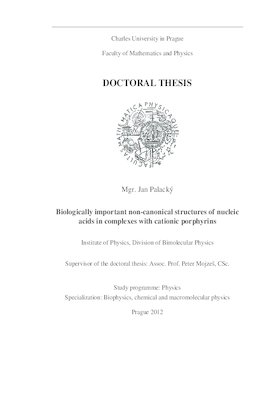Biologically important non-canonical structures of nucleic acids in complexes with cationic porphyrins
Studium biologicky významných nekanonických struktur nukleových kyselin v komplexech s kationtickými porfyriny
dizertační práce (OBHÁJENO)

Zobrazit/
Trvalý odkaz
http://hdl.handle.net/20.500.11956/59344Identifikátory
SIS: 43597
Katalog UK: 990015805410106986
Kolekce
- Kvalifikační práce [11978]
Autor
Vedoucí práce
Oponent práce
Setnička, Vladimír
Víglaský, Viktor
Fakulta / součást
Matematicko-fyzikální fakulta
Obor
Biofyzika, chemická a makromolekulární fyzika
Katedra / ústav / klinika
Fyzikální ústav UK
Datum obhajoby
21. 2. 2013
Nakladatel
Univerzita Karlova, Matematicko-fyzikální fakultaJazyk
Angličtina
Známka
Prospěl/a
Klíčová slova (česky)
DNA, guanin, kvadruplex, porfyriny, Ramanova spektroskopieKlíčová slova (anglicky)
DNA, guanine, quadruplex, porphyrins, Raman spectroscopyGuaninové kvadruplexy tvoří třídu neobvyklých konformací nukleových kyselin založených na stohování guaninových tetrád stabilizovaných prostřednictvím Hoogsteenovského párování a koordinace kationtů. Podílejí se celé řadě buněčných procesů včetně replikace, rekombinace nebo transkripce. Guaninové kvadruplexy jsou velmi rozšířené v lidském genomu, ale nejvíce se vyskytují v jednovláknových oblastech telomer bohatých na guanin. O telomerní guaninové kvadruplexy roste zájem díky jejich schopnosti inhibovat aktivitu enzymu telomeráza, který je zodpovědný za proliferaci nádorových buněk. Konkrétně jsme zkoumali konformační polymorfismus základní lidské telomerní sekvence G3(TTAG3)3 vyvolaný koncentrací DNA, kovových kationtů (K+ , Na+ ) a/nebo teplotní renaturací. Ramanova spektroskopie byla použita jako primární metoda pro toto studium, neboť, na rozdíl od běžných spektroskopických metod, jsme mohli sledovat strukturu kvadruplexu za velmi vysokých koncentrací DNA napodobujících podmínky molekulárního shlukování v buňce. Ukazujeme, že kvadruplex G3(TTAG3)3 přechází mezi antiparalelním a paralelním uspořádáním řetězců v závislosti na koncentraci DNA a iontů K+ . Kromě toho také ukazujeme, že kationické porfyriny mohou sloužit jako citlivé sondy konformace kvadruplexů. Závěrem diskutujeme možnou dimerizaci...
Guanine quadruplexes are a class of unusual nucleic acids conformations based on stacked planar guanine tetrads stabilized via Hoogsteen pairing and cation coordination. They are implicated in numerous cellular processes including replication, recombination or transcription. Guanine quadruplexes are widespread within the human genome but their occurrence is highest in the single stranded guanine-rich regions at telomeres. Telomeric guanine quadruplexes are gaining growing interest due to their ability to inhibit the activity of the telomerase enzyme, which is responsible for the proliferation of tumor cells. Specifically, we investigated the conformational polymorphism of the human core telomeric sequence G3(TTAG3)3 conditioned by the concentration of DNA, metal cations (K+ , Na+ ) and/or annealing. Raman spectroscopy was employed as the primary method for this study because, unlike common spectroscopic methods, it allowed us to monitor the quadruplex structure at very high DNA concentrations mimicking molecular crowding conditions in the cell. We demonstrate that the G3(TTAG3)3 quadruplex switch between the antiparallel and parallel strand alignment as a function of nucleoside and potassium concentration. In addition, we demonstrate that cationic porphyrins can be used as sensitive probes of the quadruplex...
